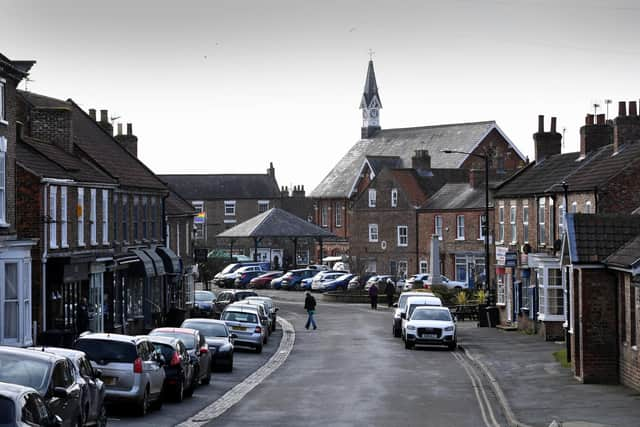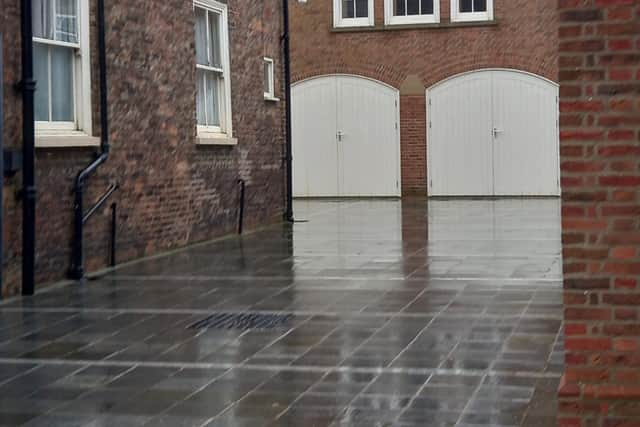Yorkshire couple refused permission for new drive at 18th-century townhouse after resurfacing with materials not 'in keeping' with its historic character
Dr Frank Kirk, a director of the Yorkshire Buildings Preservation Trust charity, and his wife Helen live at Grade II-listed Crawford House on Long Street in Easingwold.
The house was built in the late 18th century for Thomas Crawford, a leading businessman of his day who ran a horse-drawn carrier service and commissioned the property as both his home and commercial premises, with stables and cart sheds. Long Street is one of the historic entrances to Easingwold that developed during the coaching age, when it was a main route between York and Northallerton, and it is part of the town’s Conservation Area.
Advertisement
Hide AdAdvertisement
Hide AdIn early 2023, the Kirks were refused listed building consent by the former Hambleton Council in relation to their retrospective application for a new drive surface, brick gate piers supporting hung wrought iron gates and a new pedestrian gate. The works were completed before the scheme was submitted.


They had been given permission back in 2004 to build a new garage and store, and at the time the plans approved indicated that the driveway should be finished in Tees Scoria bricks, with the new gate piers finished in York handmade brick.
However, although the gates were constructed with the agreed materials, they were sited in a different location, the driveway had not been finished in Tees Scoria brick, and no alternative materials had been approved.
Helen Kirk said that they had ‘forgotten’ to ask the council to approve the materials 20 years ago, and did not realise that planning officers would wish to inspect the chosen materials before the resurfacing began in 2022.
Advertisement
Hide AdAdvertisement
Hide AdMrs Kirk said that the couple are now being pushed to install a type of surface that has ‘never’ been used at the property before and that the traditional materials will be ‘unsafe’ for them due to their age. Dr Kirk, a chemical engineer, turns 80 this year.


Instead, the finish chosen was pale grey granite reclaimed from Sheffield city centre and arranged in a regular pattern. Some of the cobbles excavated from the old driveway have been used as infill.
In a report from HM Planning Inspectorate’s Sarah Manchester which dismissed the Kirks’ appeal at the end of last year, it states: “The cobbled areas are limited in extent. Neither they nor the variation in the colour of the granite setts disguise the contemporary regimented appearance of the driveway resulting from its extent, overall colour, and its uniformity in terms ofthe shape, size, surface and geometric arrangement of the granite setts.
"The extensive granite driveway contrasts starkly with the mellow mottled brick, neighbouring buildings and walls, and the darker and more muted
Advertisement
Hide AdAdvertisement
Hide Adgrey of the footway. It is a visually obtrusive feature that draws the eye away. The driveway has a severe and uncompromising appearance that
does not harmonise with the wider streetscene.
"Taking into account the nature of granite and that the setts have been reclaimed following their use elsewhere, it seems unlikely that their appearance
would weather further or soften sufficiently to integrate the driveway into its surroundings. Consequently, the driveway fails to make a positive contribution
to the setting of Crawford House, thus eroding its special interest.
Advertisement
Hide AdAdvertisement
Hide AdThe report added that granite was ‘not a local or traditional building material’ used in the area and that the previous drive, which had been in a poor state of repair, had been laid over cobbles with no signs of granite having previously been used.
Inspector Manchester said: “I accept that cobbles and Scoria bricks might not provide a safe walking surface for the appellant and that Scoria brick is not, in any case, available. However, while Scoria brick was proposed as part of the previously approved scheme, it is not specified by the council. Instead, the council considers that a combination of traditional stone, for vehicle and pedestrian pathways, with cobbled surface elsewhere would respect the local vernacular and the setting. There is little evidence that alternative solutions to the large-scale use of granite, such as this, were explored and discounted.
She added that the gate piers are ‘conspicuously large and tall’ and that wrought iron gates would not have historically been used on the street or have been suitable for the entrance to the Crawfords’ carrier business. They are described as an ‘inauthentic addition’
The Kirks had also installed sockets for metal parking posts to prevent vehicles turning in their driveway, but Inspector Manchester deemed these to be ‘out of keeping’ with the area and said there was ‘no justification’ for their use.
Advertisement
Hide AdAdvertisement
Hide AdShe concluded: “The proposal would fail to contribute positively to local distinctiveness and sense of place. The extent, contemporary design and colour of the granite driveway jars and, in combination with other elements including the parking posts and gate piers, it would visually compete with and it would
detract from the views of the listed building. I find that the proposal would fail to preserve the special interest of the listed building. Taking into account the
scale and nature of the proposal, I find the harm to be less than substantial but nevertheless of considerable importance and weight.
"The visual improvement arising from the replacement of the previous driveway is only a limited public benefit in terms of improvements to the wider streetscene. The provision of a safer walking surface is primarily a private benefit. Taken together, I find these benefits are insufficient to outweigh the harm that has been caused to the setting as it contributes to the special interest of the listed building.”
Advertisement
Hide AdAdvertisement
Hide AdThe Kirks received support from Easingwold Town Council and from a number of neighbours, who said the driveway was a safer surface, looked good and that cobbles were not a local stone.
Mrs Kirk added: “We are planning and preparing for a further application with changes to endeavour to overcome the dismissal/refusal.
“We have consistently engaged with the planning authority and acted promptly when asked to do things. We forgot to ask for approval of the drive material. We built the gate piers in a slightly different position to keep the car off the highway when entering the drive.
“Everyone locally says the drive is such an improvement and everyone is so pleased with how it looks.”
